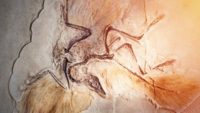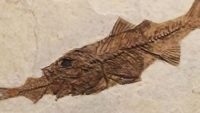Is there a way back to trusting God again? …read more Source: creation.com
By Wesley J. Smith On this classic ID the Future, hear more from bioethicist Wesley J. Smith about The War on Humans. In this episode of the series, hear about the legal movement to establish legal rights for animals, and even plants. Smith examines the meaning of the term “personhood” and its implications for human rights. Source …read more Source: id the future
A new species of duck-billed dinosaur, Ajnabia odysseus, was recently unearthed in North Africa.1 This is the first hadrosaur-type dinosaur ever discovered on the continent of Africa, and it creates a conundrum for evolutionary scientists because its location doesn’t fit their narrative. The new dinosaur, a member of the Lambeosaurinae subfamily, was discovered in a mine in Morocco in the uppermost Cretace… More… …read more Source: icr.org
By Ken Ham I love hearing stories of what our great God is doing through the Answers in Genesis ministry, our outreaches, and our two Christian themed attractions, the Ark Encounter and the Creation Museum. When I read the testimony below, I knew I needed to share it with our supporters so you could see just a sample of what God is doing through this ministry. N.R. from California sent this email to our correspondence department: I’m not asking a question, but I realized I never thanked any of you. So, thank you. When I was a teen a few [More]
By Michael Behe On this ID the Future, Lehigh University biochemist Michael Behe reads from A Mousetrap for Darwin, his latest book making the case against blind evolution and for intelligent design. The volume contains some brand new material alongside a substantial collection of essays he’s written over the years in response to critics of his three previous intelligent design books. His pro-Darwin critics have jumped all over Behe. Some have even claimed he’s ignored their objections. A Mousetrap for Darwin gives the lie to that charge. Behe has answered his critics, and done so decisively, in everything from the [More]
By Harry F. Sanders, III Though evolutionists point to the fossil record, fossils are often found where they are not expected which frequently cause revisions to their timelines. …read more Source: AIG Daily
By Ken Ham What is man and what is woman? Well, if you go by the dictionary definition, what defines a man and a woman has just changed, as the Oxford University Press has updated its definitions, primarily to be more “inclusive” of those who identify as LGBT. It’s another sign of the moral—particularly the sexual and gender—revolution, which is grounded in evolutionary naturalism, atheism, and humanism, sweeping through our culture. And, it’s also anti-science. After a petition gained more than 34,000 signatures, Oxford University Press reviewed its definition of the word woman and either removed or labelled certain synonyms [More]
Neil DeGrasse Tyson misunderstands the nature of God, the problem of evil, and the nature of miracles. …read more Source: creation.com
The platypus is perhaps the most evolution-defying creature on Earth. It’s not enough that it’s a mammal that lays eggs, has a bill like a duck, tail like a beaver, dense fur like an otter, webbed feet for swimming, hunts with its eyes closed underwater using electroreception, and wields venomous spurs, but now we can add “glows in the dark” to the long list of mind-boggling traits.1 Biofluorescen… More… …read more Source: icr.org
By Ken Ham We’re very excited that ChristmasTown at the Creation Museum and ChristmasTime at the Ark Encounter are just one week away—beginning November 27, 2020, here in N. Kentucky. Yes, our Christian attractions are open, so come stroll our spectacular garden of lights at the Creation Museum and also see the stunning lights at the Ark Encounter. These events have become family traditions for so many in our local area and across the country. These two wonderful Christmas events are free (except for a $10 parking fee). They have become family traditions for so many in our local area [More]
What is it? Is it a real fallacy? How do we respond? …read more Source: creation.com
Analogue for the greatest flood of all. …read more Source: creation.com
By Ken Ham My wife has said to me on more than one occasion, “I’m so concerned about the culture our 18 grandchildren are growing up in. They have to face challenges that we never had.” Yes, our families are having to face giants in the culture we didn’t have to deal with as kids. Even when I was a teenager growing up in Australia, I didn’t hear about abortion, gay “marriage,” transgenderism, euthanasia, pedophilia, and so on. Now, that’s not to say there weren’t such issues within the culture, but they weren’t out in the public in all their [More]
The biblical and scientific evidence concur to show that human-generated carbon dioxide will produce some warming, but there is no climate emergency that requires radical action. …read more Source: creation.com
By Ken Ham What’s a coprolite? Well, it’s fossil feces (i.e., fossil animal dung)—and it’s actually a reminder of the global flood of Noah’s day. You see, scientists have found fossilized feces from creatures like dinosaurs and fish. These remains help researchers piece together what these creatures ate and what food webs might have looked like. But why do coprolites even exist at all? Before we answer that, consider a new study that scanned hundreds of coprolites to determine what was inside. What they found were bones, scales, and teeth—one very tiny coprolite even contained some skull bones and two [More]
By Ken Ham Is there archaeological and scientific evidence for the events in the Bible? Should we start with Scripture alone? What was the “star of Bethlehem?” Is the Bible really inerrant? How do we know it’s really God’s Word? Did Jesus really rise from the dead? Whew—there are a lot of questions people have about the truth of God‘s Word! Maybe you’re wondering—or your child, grandchild, friend, or coworker is wondering—about such questions, and you want to be equipped to give a defense for the hope you have. Well, we have an event that will answer all these questions! [More]
By Michael Egnor On this ID the Future, neurosurgeon Michael Egnor discusses his recent article about Aleksandr Solzhenitsyn. Solzhenitsyn, the great Soviet dissident and recipient of the Nobel Prize in Literature, penned the essay “Live Not By Lies” in 1974, just before he was arrested and exiled from Russia. It was his advice, or even strategy, for living under totalitarianism. Solzhenitsyn’s basic advice is simply not to participate with lies, and to refuse to speak what one does not believe. It’s unnervingly relevant counsel to us in America today, where “cancel culture” and other silencing tactics, long foreshadowed in the [More]
By Heather Brinson Bruce Water conceals little-known, life-saving secrets. One of them is its ability to resist burning! …read more Source: AIG Daily
How teenagers with little knowledge and experience can hold their own in evolution classes. …read more Source: creation.com
A sneak preview of the editorial from the soon-to-be-released Creation magazine. Subscribers will be delighted with the magazine’s powerful content and brilliant graphics. …read more Source: creation.com
Some people claim children have memories of their past lives. How do we respond? …read more Source: creation.com
How Noah’s Flood formed this fascinating feature. …read more Source: creation.com
Calvin College student body president “comes out” as homosexual at a school where compromise with evolution happened years ago. …read more Source: AIG Daily
By Michael Egnor On this ID the Future neurosurgeon Michael Egnor interviews Bernardo Kastrup, a philosopher with a background in computer engineering, about consciousness, evolution, and intelligent design. Did consciousness evolve? What does the evidence suggest? And how do materialists deal with the seemingly immaterial reality that is consciousness? This is a guest episode borrowed with permission from Mind Matters, a podcast of Discovery Institute’s Walter Bradley Center for Natural and Artificial Intelligence. Source …read more Source: id the future
By Dr. Terry Mortenson This chapter will summarize the historical development of geology and in particular the development of the modern uniformitarian view of the geological record and the millions-of-years time-scale. …read more Source: AIG Daily
A frequent claim repeated by skeptics: “Eyewitness testimony is notoriously unreliable.” Let’s investigate this claim. …read more Source: creation.com
By Ken Ham So many people today think of Neanderthals in the classic evolutionary sense—primitive brutes, grunting to communicate with one another and wielding clumsy stone tools. But that evolutionary depiction—still haunting the general public—is far from the reality that further investigation has uncovered. Ongoing research actually reveals what creationists have predicted: starting with the Bible, we know Neanderthals were humans, like us, from the beginning. In just the last decade or so, we’ve reported on findings that Neanderthal people made bone instruments, wore jewelry and makeup, heated and organized their homes, had children with modern man, dove for clams [More]











































